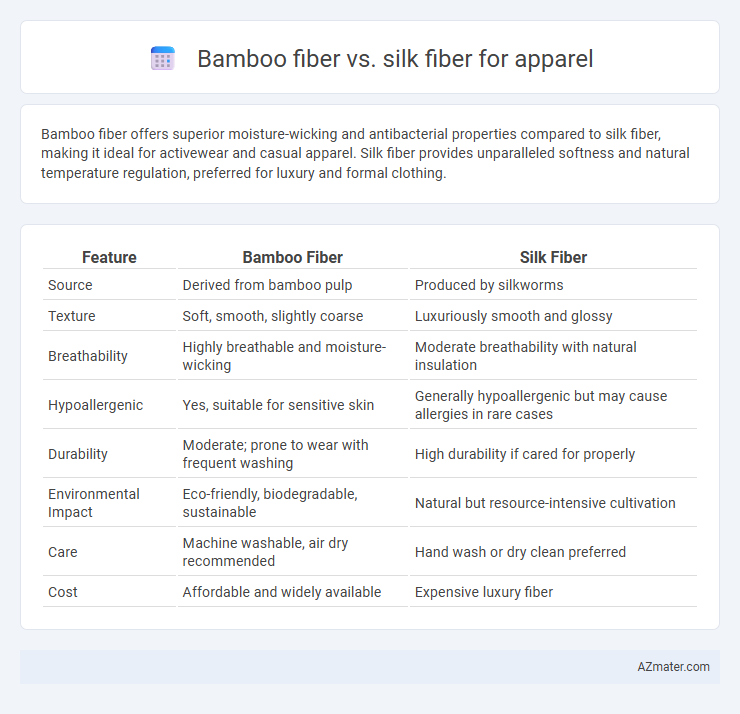Bamboo fiber offers superior moisture-wicking and antibacterial properties compared to silk fiber, making it ideal for activewear and casual apparel. Silk fiber provides unparalleled softness and natural temperature regulation, preferred for luxury and formal clothing.
Table of Comparison
| Feature | Bamboo Fiber | Silk Fiber |
|---|---|---|
| Source | Derived from bamboo pulp | Produced by silkworms |
| Texture | Soft, smooth, slightly coarse | Luxuriously smooth and glossy |
| Breathability | Highly breathable and moisture-wicking | Moderate breathability with natural insulation |
| Hypoallergenic | Yes, suitable for sensitive skin | Generally hypoallergenic but may cause allergies in rare cases |
| Durability | Moderate; prone to wear with frequent washing | High durability if cared for properly |
| Environmental Impact | Eco-friendly, biodegradable, sustainable | Natural but resource-intensive cultivation |
| Care | Machine washable, air dry recommended | Hand wash or dry clean preferred |
| Cost | Affordable and widely available | Expensive luxury fiber |
Introduction to Bamboo and Silk Fibers
Bamboo fiber, derived from the cellulose of bamboo plants, offers eco-friendly, breathable, and moisture-wicking properties ideal for sustainable apparel. Silk fiber, produced by silkworms, is renowned for its luxurious softness, natural sheen, and excellent temperature regulation, making it a premium choice in high-end fashion. Both fibers combine unique textures and functional benefits, catering to different consumer preferences in the textile industry.
Origin and Sustainability of Bamboo vs Silk
Bamboo fiber originates from the cellulose of bamboo grass, making it a highly renewable resource due to the plant's rapid growth rate and minimal need for pesticides or fertilizers. Silk fiber is produced by silkworms through the natural process of cocoon spinning, relying on sericulture that often requires substantial water, land, and mulberry leaf cultivation. Bamboo fiber's sustainability is enhanced by its biodegradable nature and lower environmental impact compared to silk, which involves energy-intensive production and ethical concerns related to silkworm harvesting.
Fiber Structure and Composition
Bamboo fiber is composed of cellulose-rich polysaccharides with a hollow, micro-grooved structure that enhances moisture absorption and breathability, making it ideal for activewear and casual apparel. Silk fiber consists primarily of fibroin protein with a smooth, triangular prism-like structure that reflects light, providing a natural sheen and superior strength, favored for luxury garments and delicate fabrics. The hydrophilic nature of bamboo fibers contrasts with the protein-based, hydrophobic silk fibers, influencing their respective comfort and thermal regulation properties in clothing applications.
Manufacturing Processes Compared
Bamboo fiber production involves mechanical crushing or chemical processing to extract cellulose, followed by spinning into yarn, while silk fiber manufacturing requires careful harvesting of silkworm cocoons and reeling raw silk threads. Bamboo fiber processes often use eco-friendly enzymes or solvents for biodegradability but may entail energy-intensive steps in chemical extraction. Silk production is labor-intensive with a focus on maintaining filament integrity, making it more delicate and costly compared to the scalable and versatile bamboo fiber manufacturing methods.
Comfort and Texture: Bamboo vs Silk
Bamboo fiber offers exceptional breathability and moisture-wicking properties, making it highly comfortable for active wear and warm climates due to its softness and smooth texture. Silk fiber is renowned for its luxurious sheen and smoothness, providing a lightweight, gentle feel that regulates temperature effectively but may lack bamboo's moisture control. Both fibers excel in comfort with bamboo favoring moisture management and silk emphasizing a rich, tactile experience.
Moisture-Wicking and Breathability
Bamboo fiber offers superior moisture-wicking properties due to its natural micro-gaps and breathable structure, allowing sweat to evaporate quickly and keep the wearer dry. Silk fiber, while smooth and lightweight, has limited breathability and moisture-wicking capabilities compared to bamboo, often retaining moisture and feeling less comfortable in high-humidity conditions. The antimicrobial properties of bamboo also enhance its performance in activewear, making it a preferred choice for moisture management in apparel.
Durability and Longevity in Apparel
Bamboo fiber exhibits strong durability due to its natural tensile strength and resistance to pilling, making it ideal for long-lasting apparel. Silk fiber, while luxurious and smooth, tends to be more delicate with a higher susceptibility to abrasion and degradation over time. For longevity in clothing, bamboo offers a more resilient option, maintaining structural integrity through repeated wear and washes.
Hypoallergenic and Skin Friendliness
Bamboo fiber is naturally hypoallergenic and excels in breathability and moisture-wicking, making it ideal for sensitive skin and reducing irritation in apparel. Silk fiber, while also skin-friendly with a smooth texture and natural protein structure, may cause allergic reactions in some individuals sensitive to sericin proteins. Both fibers offer distinct advantages, but bamboo's antimicrobial and hypoallergenic properties make it a superior choice for allergy-prone or sensitive skin.
Environmental Impact and Eco-Friendliness
Bamboo fiber excels in environmental impact due to its rapid growth, minimal pesticide use, and biodegradability, making it a highly eco-friendly option for apparel. Silk fiber, while natural and biodegradable, has a higher environmental footprint because of the intensive water use, mulberry cultivation, and labor involved in sericulture. Bamboo's sustainable cultivation and processing methods position it as a more environmentally responsible choice compared to silk in the fashion industry.
Cost, Accessibility, and Market Trends
Bamboo fiber offers a cost-effective and sustainable alternative to silk fiber in apparel manufacturing, with production expenses significantly lower due to easier cultivation and processing methods. Accessibility favors bamboo fiber, as it is widely available and grows rapidly in diverse climates, unlike silk which depends on labor-intensive sericulture and limited geographic regions. Market trends reveal increasing consumer demand for eco-friendly textiles, propelling bamboo fiber's popularity in casual and activewear, while silk maintains its niche in luxury and high-end fashion segments.

Infographic: Bamboo fiber vs Silk fiber for Apparel
 azmater.com
azmater.com